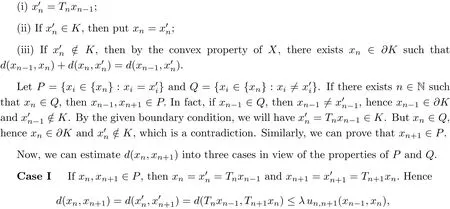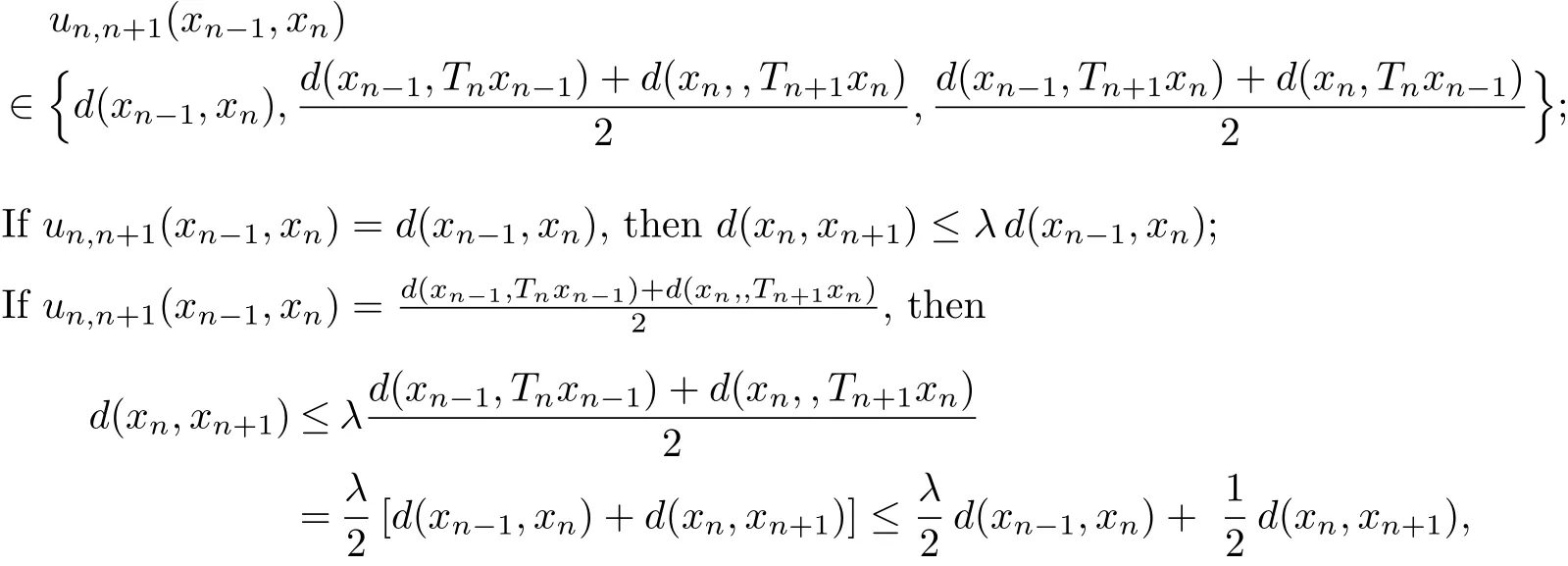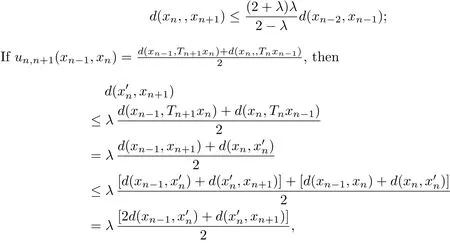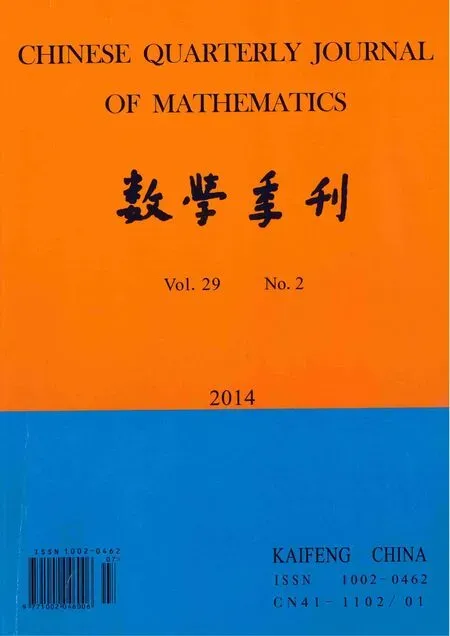Common Fixed Points for a Countable Family of Non-self Mappings in Cone Metric Spaces with the Convex Property
PIAO Yong-jie,LI Chun-hua
(College of Science,Yanbian University,Yanji 133002,China)
Common Fixed Points for a Countable Family of Non-self Mappings in Cone Metric Spaces with the Convex Property
PIAO Yong-jie,LI Chun-hua
(College of Science,Yanbian University,Yanji 133002,China)
A new common f i xed point result for a countable family of non-self mappings def i ned on a closed subset of a cone metric space with the convex property is obtained,and from which,a more general result is given.Our main results improve and generalize many known common f i xed point theorems.
common f i xed point;the convex property;cone metric space
§1.Introduction and Preliminaries
Huang and Zhang[1]recently have introduced the concept of cone metric spaces,where the set of real number is replaced by an ordered Banach space,and they have established some fi xed point theorems for a contractive type mapping on a normal cone metric space. Subsequently,some other authors[27]have generalized the results of Huang and Zhang[1]and have studied the existence of common fi xed points of a fi nite family of self mappings satisfying a contractive type condition in the framework of normal or non-normal cone metric spaces.In [8],the authors discussed some common fi xed point problems of a pair of non-self mappings de fi ned on a nonempty closed subset of a non-normal cone metric space.On the other hand, the authors recently have discussed and obtained some unique existence theorems of common fi xed points for a countable family of mappings on 2-metric spaces or metrically convex metric spaces respectively,see[9-12].
In this paper,we will give some common f i xed point theorems for a countable family of non-self mappings def i ned on a nonempty closed subset of a non-normal cone metric space with the convex property.
Let E be a real Banach space.A subset P0of E is called a cone if and only if
(i)P0is closed,nonempty and P0/={0};
(ii)a,b∈ℝ,a,b≥0 and x,y∈P0implies ax+by∈P0;
(iii)P0∩(−P0)={0}.
Given a cone P0⊂E,we def i ne a partial ordering≤on E with respective to P0by x≤y if and only if y−x∈P0.We will write x<y to indicate that x≤y but x/=y,while x≪y will stand for y−x∈int P0(the interior of P0).
The cone P0is called normal if there is a number L>0 such that for all x,y∈E,

The least positive number satisfying the above is then called the normal constant of P0.
Let X be a nonempty set.Suppose that the mapping d:X×X→E satisf i es
(d1)0≤d(x,y)for all x,y∈X and d(x,y)=0 if and only if x=y;
(d2)d(x,y)=d(y,x)for all x,y∈X;
(d3)d(x,y)≤d(x,z)+d(z,y),for all x,z,y∈X.
Then d is called a cone metric on X and(X,d)is called a cone metric space.
Let(X,d)be a cone metric space.We say that{xn}⊂X is
(e)Cauchy sequence if for every c∈E with 0≪c,there is an N such that for all n,m>N, d(xm,xn)≪c;
(f)Convergent sequence if for every c∈E with 0≪c,there is an N such that for all n>N such that d(xn,x)≪c for some x∈E.In this case,we say that x is the limit of{xn}and
A cone metric space X is said to be complete if every Cauchy sequence in X is convergent in X.
A cone metric space X is said to have the convex property if for each nonempty closed subset C of X and each x∈C and y/∈C,there exists a point z∈∂C such that

A metric space is said to be metrically convex[1314],if for any x,y∈with x/=y,there exists a point z∈X such that d(x,z)+d(z,y)=d(x,y).
Lemma 1[14]If K is a nonempty closed subset of a complete metrically convex space, then for any x∈K and y/∈K,there exists a point z∈∂K such that

The above Lemma 1 shows that a complete metrically convex space is the example of a cone metric spaces with the convex property.
Lemma 2[8]Let(X,d)be a cone metric space.Then the following properties are often useful(particulary when dealing with cone metric spaces in which the cone needs not to be normal)
(P1)If u≤v and v≪w,then u≪w;
(P2)If 0≤u≪c for each c∈intP0,then u=0;
(P3)If x≤y+c for each c∈intP0,then x≤y;
(P4)If 0≤x≤y and a∈ℝ with a≥0,then 0≤ax≤ay;
(P5)If 0≤xn≤ynfor each n∈ℕ and limn→∞xn=x,limn→∞yn=y,then 0≤x≤y;
(P6)If E is real Banach space with a cone P0and a≤λa where a∈P0and 0<λ<1, then a=0;
(P7)If c∈intP0,0≤anand an→0,then there exists n0such that for all n>n0,we have an≪c.
Remark 1It follows from(P7)that the sequence xnconverges to x∈X if d(xn,x)→0 as n→∞and xnis a Cauchy sequence if d(xn,xm)→0 as n,m→∞.In the case when the cone is not necessarily normal,we have only one half of the statements of Lemma 1 and Lemma 4 from[1].
The following is a particular form of the well-known result in[15].
Lemma 3Let(X,d)be a cone metric space with a cone P0,{xn}a sequence in X and {an}a sequence in P0and an→0.If for any m>n>1,d(xn,xm)≤an,then{xn}is a Cauchy sequence.
§2.Main Results
Theorem 1Let K be a nonempty complete and closed subset of a cone metric space X with the convex property,{Ti:K→X}i∈ℕa family of non-self mappings satisfying that there exists λ∈(0,)such that for each x,y∈K and i,j∈ℕ with i/=j,

where

If Ti(x)∈K for all x∈∂K and i∈ℕ,then{Ti}i∈ℕhave a unique common fi xed point in K.
ProofTake x0∈K.We will construct two sequences{xn}and{in the following manner.De fi ne=T1x0.If∈K,then put x1=∈/K,then by the convex property of X,there exists x1∈∂K such that d(x0,x1)+d()=d().De fi ne=T2x1.If∈K,then put x2=∈/K,then by the convex property of X,there exists x2∈∂K such that d(x1,x2)+d()=d().Continuing this way,we obtain{xn}and{x′n}

where

hence

hence

Case IIIf xn∈P and xn+1∈Q,then=Tn+1xn. Hence

where
un,n+1(xn−1,xn)

hence

hence

where

By Case II,we obtain that


hence we obtain that

By Case II again,we have

hence

But d(xn,xn+1)≤d(xn−1,+dn+1),hence we obtain that

and therefore

By Case II again,we have


or

and therefore for any n∈ℕ with n≥2,

or

So,for any n∈ℕ with n≥2,

Let δ=h−1[d(x2,x1)+d(x1,x0)]and K=h12,then K<1,δ∈P0and for all m>n≥2,

By the properties of P and Q,we can see that there are in fi nite elements xnk+1∈{xn}such that xnk+1∈P.
For any fi xed n∈ℕ,there exists an enough large k∈ℕ such that nk+1>n and xnk+1∈P. And we can obtain the following

where

If un,nk+1(x∗,xnk)=d(x∗,xnk),then for any c∈intP0,there exists a large k0∈ℕ such that for k≥k0,




Hence

and therefore,for any c∈intP,there exists a large k0∈ℕ such that for k≥k0,

Hence we get that d(Tnx∗,x∗)≪c for all c∈intP,so by Lemma 2(P2),Tnx∗=x∗for all n∈ℕ.This means that x∗is a common f i xed point of{Tn}n∈ℕ.
Suppose that p and q are all common f i xed points of{Tn}n∈ℕ,then

If u1,2(p,q)=d(p,q),then d(p,q)≤λd(p,q),hence d(p,q)=0 by Lemma 2(P6)and therefore p=q;

Hence x∗is the unique common fi xed point of{Tn}n∈ℕ.
Remark 2If K=X itself is complete,then the boundary condition is super fl ous.In this case,we can easily know that xn=x′n,hence the convex structure of X is also super fl ous.
Remark 3In fact,the condition“i/=j”in Theorem 1 can be replaced by the weaker condition“i<j”.
Remark 4Many authors in the references and others obtained many common fi xed point theorems only for a fi nite family of mappings,but we fi rst introduced the concept of the convex property to discuss the existence of common fi xed point for a countable family of non-self-mappings on cone metric spaces in Theorem 1.Since we treat non-self-mappings,we need to consider the boundary condition of the given closed subset K of X in Theorem 1.The boundary condition in Theorem 1 is very weaker than that in[8]and very di ff erent from that in[8].So,we think that our technique is very di ff erent from the previous ones and our method is new.
Theorem 2Let K a nonempty complete and closed subset of a cone metric space(X,d) with the convex property,{Ti,j:X→X}i,j∈ℕa family ofmappings,{mi,j}i,j∈ℕa family of positive integral numbers such that there exists λ∈(0,)such that for each x,y∈X and i1,i2,j∈ℕ with i1/=i2,

where

Furthermore,if(a)for each i,j∈ℕ,(∂K)⊂K,(b)for each i1,i2,µ,ν∈ℕ withµ/=ν, Ti1,µTi2,ν=Ti2,νTi1,µ.Then{Ti,j}i,j∈ℕhas a unique common fi xed point in K.

where

If ui,k,j(Ti,j(pj),Ti,j(pj))=0,then d(Ti,j(pj),Sk,j(Ti,j(pj)))≤λ0=0,hence d(Ti,j(pj), Sk,j(Ti,j(pj)))=0,i.e.,Ti,j(pj)=Sk,j(Ti,j(pj));

Hence in any situation,we have that Ti,j(pj)is a fi xed point of Sk,jfor each k with k/=i. So Ti,j(pj)is a common fi xed point of{Si,j}i∈ℕ.By uniqueness of common fi xed points of {Si,j}i∈ℕ,we haveTi,j(pj)=pjfor each i∈ℕ.Hence pjis a common fi xed point of{Ti,j}i∈ℕ.
If ujand vjare common fi xed points of{Ti,j}i∈ℕ,then they are also common fi xed points of{Si,j}i∈ℕ,hence ui=pj=vj.So j∈ℕ,{Ti,j}i∈ℕhas a unique common fi xed point pj.
Finally,we will prove that{Ti,j}i,j∈ℕhas a unique common fi xed point.Now,we prove that for eachµ,ν∈ℕ,pµ=pν.In fact,for any i1,i2,µ,ν∈ℕ withµ/=ν,since Ti1,µ(pµ)=pµand Ti2,ν(pν)=pν,Ti1,µ(Ti2,ν(pν))=Ti1,µ(pν),hence Ti2,ν(Ti1,µ(pν))=Ti1,µ(Ti2,ν(pν))=Ti1,µ(pν) by(b).This means that Ti1,µ(pν)is a fi xed point of Ti2,νfor each i2,i.e.,Ti1,µ(pν)is a common fi xed point of{Ti2,ν}i2∈ℕ.But{Ti2,ν}i2∈ℕhas a unique common fi xe point pν,hence Ti1,µ(pν)=pνfor each i1and therefore pνis a common fi xed point of{Ti1,µ}i1∈ℕ.But {Ti1,µ}i1∈ℕhas a unique common fi xed point pµ,hence pµ=pν.Let p∗=pj,then p∗is thecommon f i xed point of{Ti,j}i,j∈ℕ.The uniqueness of common f i xed points of{Ti,j}i,j∈ℕis obvious.
Remark 5In Theorem 2,the domain of{Ti,j}i,j∈ℕmust be X.In fact,we can not be sure that Ti,j(pj)∈K even if pj∈K in the proof of Theorem 2.Hence we should not suppose that the domain of{Ti,j}i,j∈ℕis K.
[1]HUANG Long-guo,ZHANG Xian.Cone metric spaces and f i xed point theorems of contractive mappings[J]. J Math Anal Appl,2007,332(2):1468-1476.
[2]ABBAS M,JUNGCK G.Common f i xed point results for noncommuting mappings without continuity in cone metric spaces[J].J Math Anal Appl,2008,341(1):416-420.
[3]ABBAS M,RHOADES B E.Fixed and periodic point results in cone metric spaces[J].Applied Math Letters, 2009,22(4):511-515.
[4]RAJA P,VAEZPOUR S M.Some extensions of Banach’s contraction principle in complete cone metric spaces[J].Fixed point theory and Applications,2008,Article ID 768294,11 pages.
[5]KADELBURG Z,RADENO´VIC S,ROSI´C B.Strict contractive conditions and common f i xed point theorems in cone metric spaces[J].Fixed point theory and Applications,2009,Article ID 173838,14 pages.
[6]JUNGCK G,RADENO´VIC S,RADOJE´VIC S,et al.Common f i xed point theorems for weakly compatible pairs on cone metric spaces[J].Fixed point theory and Applications,2009,Article ID 643840,13 pages.
[7]ILI´C D,RAKO˘CEVI´C V.Quasi-contraction on a cone metric space[J].Applied Math Letters,2009,22(5): 728-731.
[8]JANKO´VIC S,KADELBURG Z,RADENO´VIC S,et al.Assad-Kirk-Type f i xed point theorems for a pair of non-self mappings on cone metric spaces[J].Fixed point theory and Applications,2009,Article ID 7610386, 16 pages.
[9]PIAO Yong-jie.Unique common f i xed point theorems for a family of non-self maps in metrically convex spaces[J].Mathematica Applicata,2009,22(4):852-857.
[10]PIAO Yong-jie.Unique common f i xed point theorems for a family of quasi-contractive type maps in metrically convex spaces[J].Acta Mathematica Scientica,2010,30A(2):485-493(in Chinese).
[11]PIAO Yong-jie.Unique common f i xed point theorems for a family of self-maps with same type contractive condition in 2-metric spaces[J].Anal Theo Appl,2008,24(4):316-320.
[12]PIAO Yong-jie.Unique common f i xed point theorems for a family of self-maps with same quasi-contractive type condition in 2-metric spaces[J].J of Nanjing Univ Math Biquart,2010,27(1):82-87(in Chinese).
[13]ASSAD N A,KIRK W A.Fixed point theorems for set-valued mappings of contractive type[J].Pacif i c J Math,1972,43:553-562.
[14]KHAN M S,PATHAK H K,KHAN M D.Some f i xed point theorems in metrically convex spaces[J].Georgain J Math,2000,7(3):523-530.
[15]AZAM A,BEG I,ARSHAD M.Fixed point in topological space valued cone metric spaces[J].Fixed Point Theory and Applications,2010,Article ID 604084,9 pages.
tion:47H05,47H10
CLC number:O189.1,O177.91Document code:A
1002–0462(2014)02–0221–10
date:2012-07-19
Supported by the National Natural Science Foundation of China(11361064)
Biographies:PIAO Yong-jie(1962-),male(Chaoxianzu),native of Jiutai,Jilin,a professor of Yanbian University,Ph.D.,engages in nonlinear theory and space theory;LI Chun-hua(1975-),female(Chaoxianzu),native of Baishan,Jilin,a lecturer of Yanbian University,Ph.D.,engages in functional analysis and space theory.
 Chinese Quarterly Journal of Mathematics2014年2期
Chinese Quarterly Journal of Mathematics2014年2期
- Chinese Quarterly Journal of Mathematics的其它文章
- Group Twisted Tensor Biproducts over Hopf Group Coalgebras
- A Class of Solvable Lie Algebras and Their Hom-Lie Algebra Structures
- Positive Solutions for Fourth-order Delay Dif f erential Equation of Boundary Value Problem with p-Laplacian
- A New Nonlinear Integrable Couplings of Yang Equations Hierarchy and Its Hamiltonian Structure
- Cyclic Codes overF2+uF2+vF2
- The Existence and Uniqueness of the Solution for Periodical Boundary Value Problems of 2kth Order Dif f erential Equations with Resonance
